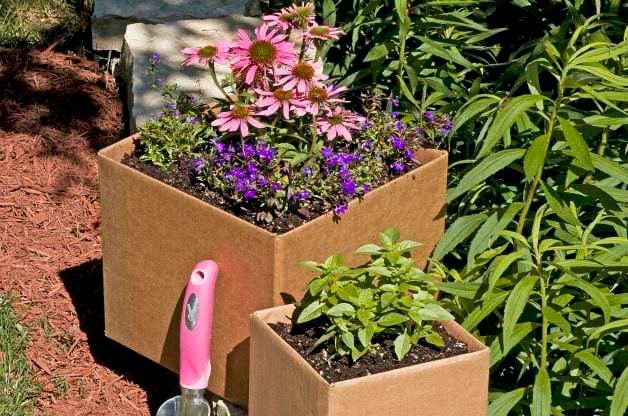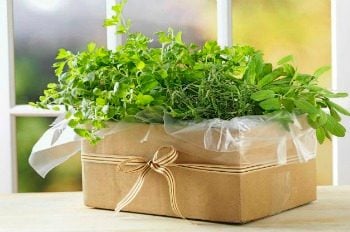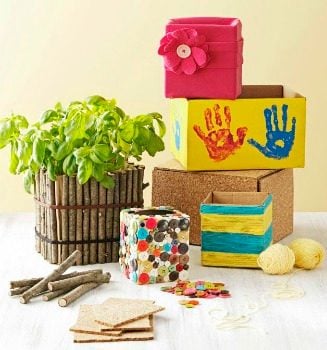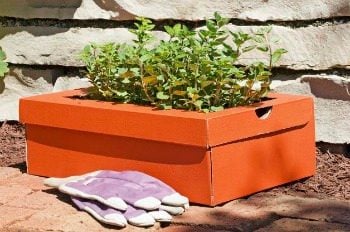Save Money and Recycle with Cardboard Gardening
Updated: Mar. 21, 2024

With this eco-friendly, free and easy gardening method, you’ll have a better garden in no time! Just place cardboard in the fall and you'll be ready to plant in spring.
I’m a bargain hunter. A penny-pincher. A cheapskate. Nothing makes me happier than finding thrifty and resourceful ways to save money on the things I need or want. I’m also a gardener. And, as anyone who has ever tended a patch of tomatoes can attest, it’s alarmingly easy to spend a lot of money on a garden. So you can imagine my excitement when I discovered a super cheap, super simple way to have a better garden. Cardboard gardening!
A couple of years ago, I heard that cardboard made a good foundation for new garden beds, so that fall I grabbed a few recycled boxes, flattened them in the backyard and waited. In spring, when it came time to plant, the cardboard had broken down and I had a lovely new garden bed of rich soil, ready for planting. Psst—check out more garden chores for fall.
Something that’s free, easy and makes for a better garden? I was hooked.
Now, I know my two green-thumbed—and thrifty— grandmothers would probably giggle if they heard me going on and on about this wonderful “new” decomposable method. After all, generations of gardeners have used paper and cardboard in one way or another. But what if cardboard is more than just mulch or a weed barrier? What if it’s the key to a whole new approach to gardening—one that lets you spend less and use less while still getting excellent results?
A few brainstorming sessions later with the Birds & Blooms staff and experts, and we had a laundry list of ideas for our new approach. We call it cardboard gardening. Here are 9 ways to use cardboard in the garden.
Use Cardboard in Compost
When it comes to composting, you need a lot more brown matter (paper, leaves, sticks, etc.) than green (kitchen scraps). Essentially, you need a ratio of 25 to 1. Cardboard really comes in handy here—it’s a compost pile’s best friend!
Whether you have a compost pile or a bin, cardboard is perfect brown material. Just break it down into manageable pieces and throw it in with the other stuff. As it decomposes, it will add nutrients your plants will love.

Cardboard Container Gardening
These days, the cost of container gardening can really add up. Save money and spend it on plants instead by using cardboard boxes as the containers. Treat them the way you’d treat conventional containers: Fill with soil, make sure you have proper drainage and don’t forget to water.
But will a cardboard container really hold up for an entire season through watering, wind, rain and everything else you and nature throw at it? Along with a few other gardeners around the country, we tested some out, and the answer is—yes!
Sure, this approach might not be for those who like everything neat and tidy, but if you’re adventurous, think inside the box here! Remember, with the right plants, by the end of summer you can’t see the container anyway. If you’d like, add a little reinforcement with tape in any weak areas. Or line the box with a plastic bag with drainage holes to keep it from getting soggy. And if looks are important to you, try some of our ideas for dressing it up (keep reading!).
Decorate Cardboard Containers

They say you can’t make a silk purse out of a sow’s ear. But you really can make plain old cardboard look good, and it doesn’t take much time, effort or money.
First the easy ideas: You can paint the box, wrap it in paper or cover it in old material. And if you’re up for being a bit more creative, try some of our other favorite materials: yarn, twine or rope.
My personal favorite is laminate or cork tiles. They’re available with amazing designs these days, and you can pick them up at a home improvement store for just a few bucks. You’ll probably need extra reinforcement for these, but they can really transform a cardboard box into a container worthy of the front porch.
Next, check out 5 easy ways to dress up your canning jars.
Use Cardboard as a Weed Barrier
Cardboard, newspaper and other compostable material is a quick and easy fix for weed problems. In just one growing season, you can reduce weeds by 75 percent or more.
Just place pieces of cardboard around the plants you want to protect. Water immediately to help the cardboard stay in place. (I say this because I’ve been that person chasing runaway cardboard caught by the wind.) You can add soil or mulch on top to reinforce it, too. The cardboard will suppress the weeds and eventually break down into the soil, adding useful organic matter.
Here’s 12 more ways to win the war on weeds.
Start New Flower Beds with Cardboard
The easiest way to start a brand-new garden bed is not with a tiller. Forget sweating behind heavy machinery, and use cardboard instead. That’s how I first discovered the magic.
This method will take a bit longer, but it really is the simplest way to start a bed. Just outline the shape you want on your grass (try using a garden hose to form the template), use edging to keep the grass out, then cover the area with cardboard. Water immediately and top with soil, mulch, leaves or anything you have on hand to hold the cardboard down.
After a few months, you’ll start to see the cardboard breaking down. Underneath, you’ll find fresh garden soil, ready for plants. The best time to do this is in fall, so the cardboard can break down over the winter and you’ll be ready to go in spring. The prep work probably won’t take much more than half an hour.
Another easy gardening tip: Fall leaves make great mulch for your lawn.
Build a Pathway with Cardboard
Creating a new garden path might seem like a lot of work, but you can have a simple one in about an hour. No, this isn’t a fancy-schmancy infomercial-type promise. All you need is cardboard, bricks or something else to outline the path, and mulch.
You’re going to be placing the cardboard directly onto the grass or whatever other surface you’re working on. Cardboard is thick enough so that you shouldn’t have any stray grass or weeds poking up through it. (If you do, just add more cardboard.) Place the cardboard in the shape you want the path to take. Outline with bricks, then cover with soil and mulch. Voilà!
Cardboard Seed Starters
The cost of seed-starting supplies can add up fast. Grow lights, special pots, fancy mats—I’ve tried them all. Cardboard boxes are the perfect solution for starting seeds because you can keep them growing inside longer, giving you stronger seedlings. (Don’t forget to provide them with plenty of light for optimum results.) Then just plop the whole thing, box and all, into your garden.
This approach is also perfect for kids. It’ll teach them to care for a garden—keep those seedlings thinned out, don’t forget to water, be patient—on a small scale before they move to a bigger space. Here’s how to host a seed-starting party.
Cardboard Windowsill Herb Planter
Isn’t the idea of herbs growing along your kitchen windowsill divine? I love the idea of snipping off a few bits of fresh basil or cilantro to throw into whatever’s cooking.
You can have your herbs cheaply, too, with cardboard. Line up small boxes in a window that gets good light—shoe boxes are one option—and fill with soil and herbs. You’ll be snipping and clipping in no time.
Check out the top 10 herbs to grow.
Shoe Box Garden

Finally, there’s a good use for all those shoe boxes you’ve been collecting for no reason! One of our photographers eagerly volunteered his wife’s shoe box collection for our tests.
Keep in mind that most shoe boxes aren’t very deep, so you’ll need to choose items that don’t need a lot of growing space. Lettuce, petite carrots and herbs are all good options.
For a cleaner appearance, we liked leaving the lids on our shoe boxes and just cutting a rectangle into the top. Then just add your soil and plants. You can put a shoebox garden in practically any corner of your yard or patio. It’s also a good project to do with kids, because it’s manageable. They can really take ownership of their small plots.
Here’s our guide to gardening tasks for kids of every age.
Cardboard Boxes in Square Foot Gardens
Square foot gardening keeps growing in popularity, and with good reason: You can grow more in less space. I use this method in my own backyard, and it works beautifully.
We’re giving the method a new spin with cardboard gardening. Use cardboard boxes to mark off your “squares” instead. Sure, most boxes aren’t perfect squares, but they don’t need to be. Add your boxes to a raised bed or an empty space in your yard. Follow the guidelines on how many plants to grow in each square foot; just reconfigure a bit if your boxes are bigger or smaller. Then you’re off.
Have kids try this method, too. My son and daughter love having their own spaces and planning what to put in each square.
Check out 10 fast-growing vegetables you can harvest quickly.
